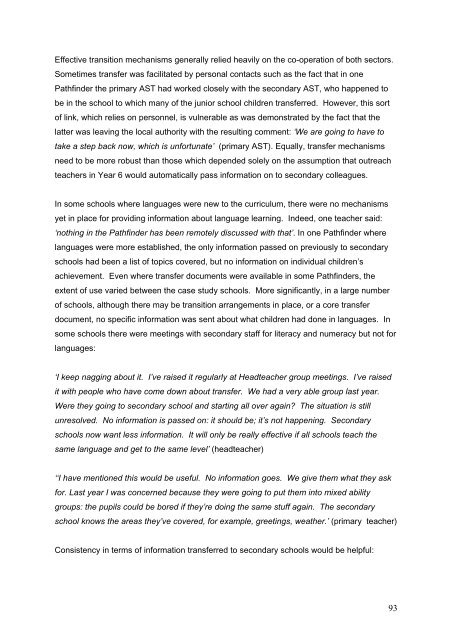Evaluation of the Key Stage 2 Language Learning Pathfinders
Evaluation of the Key Stage 2 Language Learning Pathfinders
Evaluation of the Key Stage 2 Language Learning Pathfinders
You also want an ePaper? Increase the reach of your titles
YUMPU automatically turns print PDFs into web optimized ePapers that Google loves.
Effective transition mechanisms generally relied heavily on <strong>the</strong> co-operation <strong>of</strong> both sectors.Sometimes transfer was facilitated by personal contacts such as <strong>the</strong> fact that in onePathfinder <strong>the</strong> primary AST had worked closely with <strong>the</strong> secondary AST, who happened tobe in <strong>the</strong> school to which many <strong>of</strong> <strong>the</strong> junior school children transferred. However, this sort<strong>of</strong> link, which relies on personnel, is vulnerable as was demonstrated by <strong>the</strong> fact that <strong>the</strong>latter was leaving <strong>the</strong> local authority with <strong>the</strong> resulting comment: ‘We are going to have totake a step back now, which is unfortunate’ (primary AST). Equally, transfer mechanismsneed to be more robust than those which depended solely on <strong>the</strong> assumption that outreachteachers in Year 6 would automatically pass information on to secondary colleagues.In some schools where languages were new to <strong>the</strong> curriculum, <strong>the</strong>re were no mechanismsyet in place for providing information about language learning. Indeed, one teacher said:‘nothing in <strong>the</strong> Pathfinder has been remotely discussed with that’. In one Pathfinder wherelanguages were more established, <strong>the</strong> only information passed on previously to secondaryschools had been a list <strong>of</strong> topics covered, but no information on individual children’sachievement. Even where transfer documents were available in some <strong>Pathfinders</strong>, <strong>the</strong>extent <strong>of</strong> use varied between <strong>the</strong> case study schools. More significantly, in a large number<strong>of</strong> schools, although <strong>the</strong>re may be transition arrangements in place, or a core transferdocument, no specific information was sent about what children had done in languages. Insome schools <strong>the</strong>re were meetings with secondary staff for literacy and numeracy but not forlanguages:‘I keep nagging about it. I’ve raised it regularly at Headteacher group meetings. I’ve raisedit with people who have come down about transfer. We had a very able group last year.Were <strong>the</strong>y going to secondary school and starting all over again? The situation is stillunresolved. No information is passed on: it should be; it’s not happening. Secondaryschools now want less information. It will only be really effective if all schools teach <strong>the</strong>same language and get to <strong>the</strong> same level’ (headteacher)‘‘I have mentioned this would be useful. No information goes. We give <strong>the</strong>m what <strong>the</strong>y askfor. Last year I was concerned because <strong>the</strong>y were going to put <strong>the</strong>m into mixed abilitygroups: <strong>the</strong> pupils could be bored if <strong>the</strong>y’re doing <strong>the</strong> same stuff again. The secondaryschool knows <strong>the</strong> areas <strong>the</strong>y’ve covered, for example, greetings, wea<strong>the</strong>r.’ (primary teacher)Consistency in terms <strong>of</strong> information transferred to secondary schools would be helpful:93

















